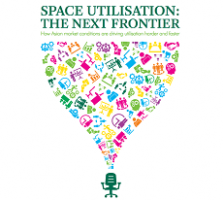October 22, 2015
Shrinking Asian workplace density could impair business performance 0
 Workplace static density, i.e. the space per sq. ft. per workstation, has halved in many Asian markets over the last decade and in many parts of Asia, this has already reached a point where further reductions will impact productivity, performance and retention. In Hong Kong, India and China, workplace space has shrunk from 100 sq. ft. per desk to 50-60 sq. ft. per desk. This figure is nearly half that of Europe and the US, where density norms are around 150-200 sq. ft. per desk. Elsewhere, in Australia and New Zealand, standards remain more generous at around 90-150 sq. ft. per desk. CBRE’s recent report, Space Utilization: The Next Frontier, looks at how organizations across the region are now under pressure to drive down costs by increasing their workplace ‘static density’ and suggests ways in which companies can use workplace density and utilization data to drive efficiency and business performance.
Workplace static density, i.e. the space per sq. ft. per workstation, has halved in many Asian markets over the last decade and in many parts of Asia, this has already reached a point where further reductions will impact productivity, performance and retention. In Hong Kong, India and China, workplace space has shrunk from 100 sq. ft. per desk to 50-60 sq. ft. per desk. This figure is nearly half that of Europe and the US, where density norms are around 150-200 sq. ft. per desk. Elsewhere, in Australia and New Zealand, standards remain more generous at around 90-150 sq. ft. per desk. CBRE’s recent report, Space Utilization: The Next Frontier, looks at how organizations across the region are now under pressure to drive down costs by increasing their workplace ‘static density’ and suggests ways in which companies can use workplace density and utilization data to drive efficiency and business performance.
Low densities in the workplace imply reductions in shared collaborative and isolated work settings, and more generally cramped space—impacting teamwork, decision making and ability to focus. CBRE regards below 60 sq. ft. per desk as a clear productivity danger zone; reducing space below this level places staff productivity, performance and retention at risk. Tight desk space leads to lack of privacy, increase of noise and levels of distraction from neighbours, which negatively impacts employees, thus leading to decreased productivity. Even at 60-100 sq. ft. per desk, there are risks that not all aspects of work are fully supported, particularly knowledge-based work.
There are, however, alternatives that will allow firms to balance the pressures of cost and density.
Said Peter Andrew, Director of Workplace Strategy, CBRE Asia. “In order to drive space efficiency and business performance, we propose organizations to implement new and dynamic ways of working, including more focused and more collaborative settings that are easily accessible through enhanced employee mobility within the workplace. This will drive down costs per person by optimizing the utilization of work settings,”
“Once workers are dynamic in the way that they use space, then it becomes quite straightforward to recapture underutilized space, generally referred to as ‘desk sharing’.
However, poorly implemented desk sharing is a very real business risk created by those who are focused only on cost savings and have limited understanding of the impact on organizational performance. When executed well, this approach improves the real estate bottom line whilst enhancing overall employee productivity, performance and engagement, creating better quality work environments,” adds Mr Andrew.
Benchmarking metrics such as workplace density and space utilization are becoming more critical in helping corporate occupiers make informed workplace and real estate decisions, and manage their real estate as a strategic asset, however, this needs to be approached in the right way.
“CBRE has regularly observed businesses undertake utilization studies, making misinformed decisions through poorly collected and interpreted data and undertaking strategies that are perceived to drive down costs—which often never eventuate—and in reality cause organizational chaos. A lack of understanding of this data may lead to companies increasing static and dynamic workplace density at the expense of productivity and the satisfaction of workers,” said Dr Henry Chin, Head of Research, CBRE Asia Pacific.
“Corporate occupiers must develop a complete understanding of how their people work, and what their organizational objectives and imperatives are. It is only by aligning these two fundamental perspectives that companies can implement a workplace strategy capable of achieving cost effective business transformation,” Dr Chin added.














